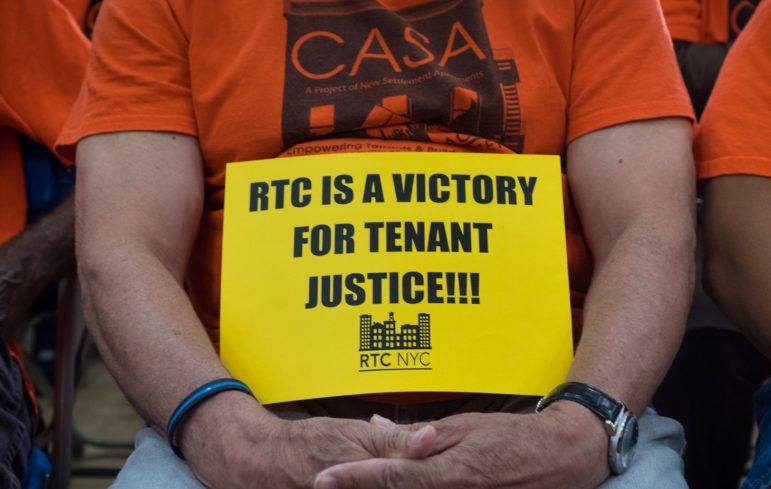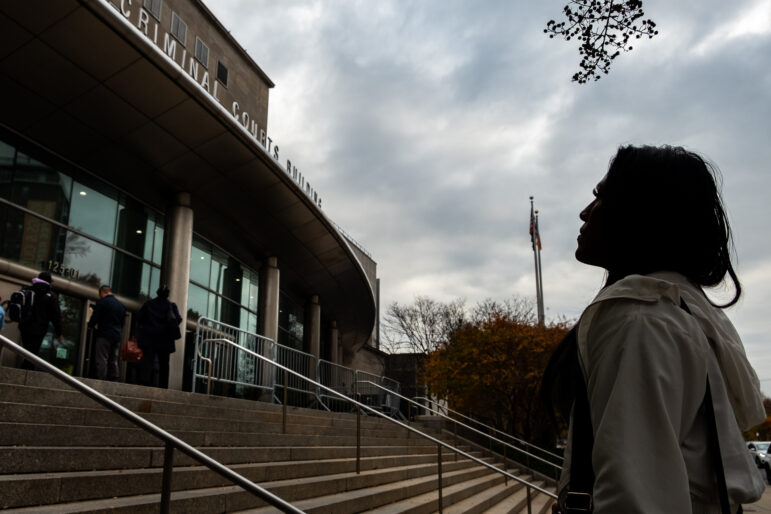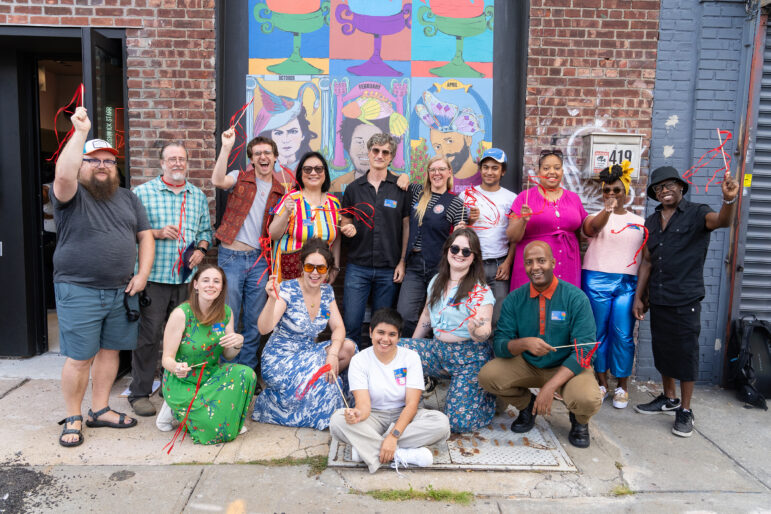
Edwin J. Torres/Mayoral Photog
A tenant advocate cheers the new Right to Counsel policy at the bill signing in 2017. While in its earliest stages of implementation, the RTC policy is one that could be adopted in other cities where displacement is a concern (which seems to be most cities).
Worries about development driving displacement in Inwood are what led a group of protesters to occupy Councilmember Ydanis Rodriguez’s small neighborhood office last week. But those concerns are also what fueled some of the opposition to a mass transit referendum in Nashville this spring and to a mixed-use development plan in Lynn, Mass., this summer. They’re behind tenant activism from Atlanta to El Paso, inspiring cooperative land deals from Boston to Buffalo, cropping up in discussions of Portland’s decreasing bus ridership and Los Angeles’ large homeless population and the demise of mobile-home parks near Phoenix.
The fear that the traditional tactics of urban growth—mixed-use development and transit investment—are forcing low- and moderate-income people from their homes unifies communities in cities large and small, from coast to coast.
Amid a national housing crisis that is now New York Times front-page material, coherent federal policy is absent and would-be national candidates are silent. So the fight to preserve economic diversity in American cities is largely being waged place to place, with neighborhood activists and nonprofit organizations in the vanguard.
There are common threads, however, from city to city and from neighborhood to neighborhood. So the Association for Neighborhood and Housing Development (ANHD) has created a toolkit (found at antidisplacementtoolkit.org) for activists looking for policies that might protect low-income people from displacement. Aimed primarily at advocates in New York, it could also serve counterparts across the country.
“It comes from the sense that over that last couple of years we—certainly in New York City but also elsewhere throughout the country–have realized that anti-displacement concerns are the central issue or among the central issues–that you can’t have a policy conversation about affordable housing or development in dense, high-market cities without displacement policy being an absolutely essential part of that,” says Benjamin Dulchin, ANHD’s executive director. To this point, however, there’s been no comprehensive effort to look at what those policy choices are. “As we balance growth and affordability and displacement, displacement cannot be an afterthought.”
The toolkit is a website that combines briefs on different policy ideas with case studies of how some have been applied. It includes policies that are being implemented here—like the certificate of no harassment program and community land-trusts—and those that have to come to New York, like a pied a terre tax or a development moratorium.
“On the one hand, we’ve done a lot here and we’ve come up with a lot here,” says Emly Goldstein, ANHD’s senior campaign manager. “But there’s also a lot in the whole rest of the country that’s actually relevant.” And outside the county, too: The empty home tax in Vabcouver, B.C., made ANHD’s list. “There’s stuff that we might dismiss as crazy talk that’s real elsewhere. So, let’s look at that.”
Each city is shaped by its unique history, demographics and politics. Rent regulation is part of the policy fabric in New York City, but are expressly prohibited by state law in many places. While leftist organizations lead the fight against displacement in most places, it was the Koch Brothers, rainmakers of the right, who were the primary killers of that transit plan in Nashville.
New Yorkers have advantages that residents of some other cities don’t. The expectation that mayors will address affordable housing—created three decades ago with Mayor Koch’s Ten-Year Plan–is unique to local political culture. And ideas that might have been dismissed a few years ago—right to counsel, for instance–are now established city policies in New York.”The last nine months, there’s been some really important steps forward,” says Dulchin. “That City Hall has listened and responded to what’s going on—that’s notable. These are a whole set of tools that a year ago were seen as being a bridge too far.”
Even within the city, displacement risks look different from neighborhood to neighborhood. “Speculation and displacement shows up one way in a small homes neighborhood like East New York and shows up a different way in a place like Jerome Avenue–and a different way in a place in Gowanus,” says Joan Byron, the director the Neighborhoods First Fund, which supported the creation of the toolkit (and supports City Limits’ ZoneIn project).
Yet there are opportunities for learning across settings. “It’s only becoming real to a lot of us how much the rest of the country is becoming like new York,” says Byron, a veteran planner. What’s struck her is how robust the grassroots infrastructure is in cities around the country, and how common it’s becoming for advocates to see their challenge as structural in nature—owing not to personal choices but to the basic architecture of the American economy. “We’re up against an incredibly well-armed and ruthless adversary in the real-estate industry,” Byron notes.
One of the questions that’s come up in New York’s rezoning debates is whether rezonings themselves are necessary, and whether the dangers they pose are larger than any set of policy tools can hope to offset. The basic notion that New York City has a general housing shortage—which is undermined somewhat by data showing significantly lower vacancy rates for higher-income people—has come into question.
“Even if there was not new development in New York City, we would still have a displacement crisis,” says Dulchin. People of means are staying in and moving to cities, and that threatens people with less who live there now. This reality only underscores the stakes of the fight: Since cities are increasingly the epicenters of innovation and opportunity in the U.S., there are deep racial and class implications to who gets to stay and who has to move. “It is an essential equity question,” Dulchin says.
The toolkit does contain tools that go beyond merely managing the problems associated with the private real-estate market to actually conceiving alternative models—like the community land trust model, under which some land is permanently reserved for affordable housing. “I think a lot of the policies in the toolkit could also be steps toward altering that framework and building enough security and power to shift that landscape,” says Goldstein.
The national nature of the displacement risk seems to beg for federal policy. So far, there’s been little popular discussion of the problem at the national level, let alone a debate about possible solutions.
The feds could at least stop doing harm, according to Byron, by pulling back from changes to public-housing and Section 8 rent rules and repairing some of the damage President Trump’s tax cut did to low-income housing tax credits.
More ambitious ideas like a foreclosure moratorium or a public bank seem out of reach at the moment but, Byron says, “With the midterms ahead and with who knows what after that and with the socialist wave just beginning to take on momentum, I think people are going to form much more radical demands—and those demands have a real chance.”
For now, within the five boroughs, the newness of policies like the certificate of no harassment and right to counsel means no one can say for sure whether and how they will work. As the de Blasio administration closes in on its fifth neighborhood rezoning, in Inwood, it’s only two years since the very first one, affecting East New York, was passed, and there’s been little comprehensive research on what the impact was.
This uncertainty seems to be part of what drove Council subcommittee on zoning and franchises chairman Francisco Moya to declare on Thursday, at a vote on the Inwood plan, that he was pausing negotiations with the de Blasio administration over additional rezonings until more steps are taken to learn what impact the previous ones have had.
Still, while little is known about how the tools will perform, there’s plenty of evidence that trying nothing will do harm, according to Byron.
“A lot of the tools are brand new and it’s going to be a while before we have evidence of how they do work and whether there are unintended consequences,” Byron says. “But it’s like a medical situation where the drug hasn’t been tested but patients are dying. The potential downside of implementing one of these tools – how does that stack up with the cost that we know we’re incurring from the way things are now?”









One thought on “A Toolkit to Fight Displacement in NYC Neighborhoods, Other U.S. Cities”
Pingback: New Toolkit Takes Anti-Displacement Policy Planning to the Next Level – ANHD 2016